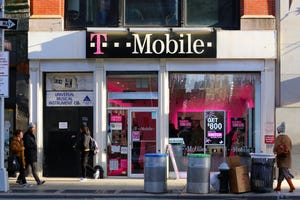Vodafone's open-networks obsession reaches broadband
The UK-based operator has built a gateway using products from different suppliers in a move it likens to open RAN for broadband.

Big telecom seems obsessed with breaking up its networks and then rebuilding with a different supplier for every part or line of software code.
Much more of it and the list of vendors for any one operator will soon be longer than the queue outside a filling station this week in the fuel-starved UK.
The latest disaggregation, as the industry would have it called, is brought to you by Vodafone and a handful of engineering friends. While most of the recent focus has been on the highly politicized mobile network, the tests carried out by Vodafone and company were all about fixed broadband – and specifically a box called the broadband network gateway (or BNG).
Figure 1:  Vodafone's headquarters in the UK town of Newbury.
Vodafone's headquarters in the UK town of Newbury.
It is an important bit of the network that aggregates and routes data traffic and looks after various customer-management functions. Normally, all the hardware and software in the BNG would come from the same supplier.
The market leader is understood to be Juniper, but others have included Cisco, Ericsson (through its Redback subsidiary), Huawei and Nokia.
Vodafone, however, claims to have built a disaggregated BNG from hardware and software provided by a multitude of vendors.
By taking advantage of a technology standard labelled TR-459, devised by the Broadband Forum (a prominent industry association), it was able to separate the control plane – the brain of the network – from the user plane, the part that ferries traffic to the appropriate destination.
Thanks to standardization, it could then make one vendor's control plane synchronize with another's user plane.
Open RAN for broadband
The effort has been likened by Johan Wibergh, Vodafone's chief technology officer, to open RAN, a move to disaggregate the mobile network that is seen as a threat to equipment giants such as Ericsson, Huawei and Nokia.
The disaggregated BNG could entail similar risks for the suppliers of integrated boxes, although two of them – Cisco and Nokia – were involved in Vodafone's tests.
It is also an opportunity for new players like Casa Systems, Benu Networks and UfiSpace, says Jeff Heynen, the vice president of broadband access and home networking for analyst firm Dell'Oro. Benu and Casa were the other two players involved in the tests that Vodafone carried out.
But avoiding lock-in – such a priority for open RAN – is probably not the main objective here, says Julie Kunstler, a principal analyst with Omdia (a sister company to Light Reading).
"In my opinion, vendor tie-in is less of an issue here than enabling flexibility and cloud-based functions for operators," she says.
"Disaggregated BNG with cloud-based controls and interoperability is important to operators as fixed broadband continues to grow in terms of subscribers and subscriber types, broadband speeds, services and vendors."
Heynen agrees and is clearly not surprised that Vodafone – with its jumble of copper, fiber, cable and fixed wireless technologies – is so active here.
Disaggregation would allow it to move its BNG functions around the network more easily, he explains. It could centralize them in a big data facility to address lots of customers, move them into a headend or central office or even put them right out at the edge of the network to support smaller customer groups.
"One of the reasons for the focus on the BNG is that existing BNG platforms have generally been deployed in silos, with most supporting residential broadband services," he says.
"One of the goals of more open BNGs is that they can also provide aggregation functions for enterprise and mobile transport applications."
Of particular interest to Vodafone is the ability to plonk its main control functions in the cloud and then work separately with a smaller number of other features. Scaling these up or down to suit needs would obviously be less cumbersome with those control functions stripped out and managed elsewhere.
Want to know more about 5G? Check out our dedicated 5G content channel here on Light Reading.
This sort of rearchitecting has a parallel in mobile. By virtualizing their radio access networks, some operators hope to shift the baseband processing that normally happens at mobile sites into centralized facilities, reducing the amount of equipment they need.
The industry, though, is still not entirely convinced of the business case for this cloud RAN (or C-RAN).
"The economics of C-RAN are not yet proven beyond doubt and the equipment which is removed from sites is quite small in the grand scale of a multi-band macro cell basestation," said a spokesperson for UK telecom incumbent BT.
The disaggregated BNG is unlikely to garner as much attention as open RAN, whatever Wibergh thinks. Even if did strengthen alternatives to Chinese vendors, there has not been the same political clamor in broadband as there has in mobile to rid networks of Huawei and ZTE.
One of open RAN's original objectives was to produce new and more open specifications, moreover, whereas the TR-459 standard already appears ready. And Vodafone, for now, seems to be the only big service provider making a noise about disaggregated BNG.
While that could change, reducing upfront costs – another goal of virtualization and open RAN – would probably not make a huge difference.
Broadband access equipment accounts for a relatively small share of telco spending. In 2019, for instance, operators worldwide paid about $8.4 billion for broadband access products, according to Omdia, while annual investments in the radio access network range between $30 billion and $35 billion.
Most of the fixed-line expenditure goes on digging up streets. Try virtualizing that.
Related posts:
— Iain Morris, International Editor, Light Reading
Read more about:
EuropeAbout the Author(s)
You May Also Like




.jpg?width=300&auto=webp&quality=80&disable=upscale)







